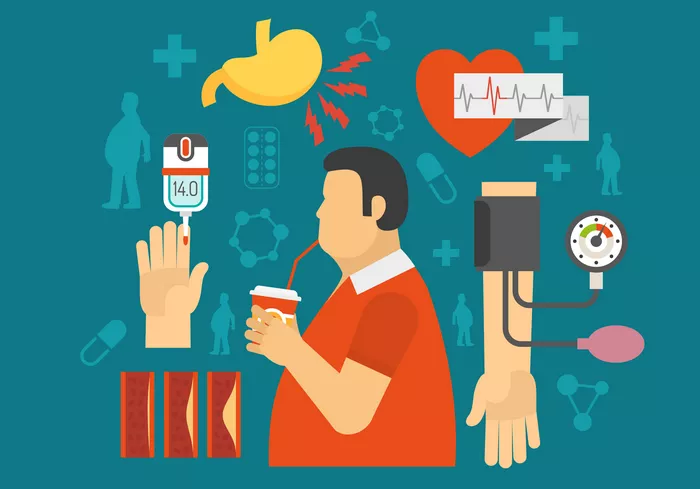High insulin levels, or hyperinsulinemia, can be a precursor to various health issues, including type 2 diabetes. This article delves into the symptoms of high insulin levels, their underlying causes, and their broader impact on health.
What is Insulin and Its Role in the Body?
Insulin is a hormone produced by the pancreas that plays a crucial role in regulating blood sugar levels. After eating, blood sugar levels rise, prompting the pancreas to release insulin. Insulin facilitates the uptake of glucose by cells for energy or storage as glycogen in the liver and muscles. This process helps maintain stable blood sugar levels.
What is Hyperinsulinemia?
Hyperinsulinemia occurs when the body produces excess insulin in response to blood sugar levels. This condition is often associated with insulin resistance, where the body’s cells do not respond effectively to insulin, leading the pancreas to produce even more insulin to compensate. Hyperinsulinemia can occur in the absence of diabetes, but it often precedes the development of type 2 diabetes.
Causes of High Insulin Levels
Several factors can contribute to high insulin levels, including:
Insulin Resistance: The primary cause of hyperinsulinemia is insulin resistance, where the body’s cells become less responsive to insulin.
Obesity: Excess body fat, particularly around the abdomen, is strongly linked to insulin resistance and high insulin levels.
Diet: Diets high in refined carbohydrates and sugars can lead to spikes in blood sugar levels, prompting increased insulin production.
Genetics: Genetic factors can play a role in insulin sensitivity and the risk of developing hyperinsulinemia.
Sedentary Lifestyle: Lack of physical activity can contribute to insulin resistance and high insulin levels.
Symptoms of High Insulin Levels
1. Increased Hunger and Cravings
One of the most common symptoms of high insulin levels is increased hunger and cravings, particularly for sugary and carbohydrate-rich foods. High insulin levels can cause blood sugar to drop rapidly, leading to feelings of hunger soon after eating.
2. Weight Gain and Difficulty Losing Weight
High insulin levels promote fat storage, particularly around the abdomen. Individuals with hyperinsulinemia may find it challenging to lose weight despite efforts to diet and exercise. This weight gain is often associated with increased fat deposition rather than muscle mass.
3. Fatigue and Weakness
Excess insulin can lead to fluctuations in blood sugar levels, causing periods of low blood sugar (hypoglycemia). This can result in feelings of fatigue, weakness, and overall low energy levels.
4. Frequent Urination and Thirst
Although more commonly associated with diabetes, frequent urination and excessive thirst can also be symptoms of high insulin levels. These symptoms occur as the body attempts to rid itself of excess glucose through urine, leading to dehydration.
5. Increased Fat Storage
High insulin levels signal the body to store excess glucose as fat. This can lead to increased fat storage, particularly in the abdominal area, contributing to a condition known as central obesity or visceral fat accumulation.
6. Skin Changes
Acanthosis nigricans, a condition characterized by dark, velvety patches of skin, typically in body folds and creases, can be a sign of high insulin levels. This condition is commonly seen in areas such as the neck, armpits, and groin.
7. Polycystic Ovary Syndrome (PCOS) in Women
Hyperinsulinemia is often associated with PCOS, a hormonal disorder common among women of reproductive age. Symptoms of PCOS include irregular menstrual cycles, excessive hair growth (hirsutism), acne, and ovarian cysts. High insulin levels can exacerbate these symptoms and contribute to the development of PCOS.
8. High Blood Pressure
High insulin levels can contribute to increased blood pressure. Insulin can stimulate the sympathetic nervous system, leading to vasoconstriction and higher blood pressure. Additionally, hyperinsulinemia can promote sodium retention, further increasing blood pressure.
9. Increased Triglyceride Levels
High insulin levels can lead to elevated triglyceride levels in the blood. Triglycerides are a type of fat that, when present in high amounts, increase the risk of cardiovascular disease. Insulin promotes the synthesis of triglycerides in the liver, contributing to hypertriglyceridemia.
10. Brain Fog and Cognitive Issues
Fluctuations in blood sugar levels due to high insulin can affect brain function, leading to symptoms such as brain fog, difficulty concentrating, and memory problems.
Long-term Health Implications of High Insulin Levels
1. Development of Type 2 Diabetes
One of the most significant risks associated with high insulin levels is the progression to type 2 diabetes. Insulin resistance and hyperinsulinemia can eventually exhaust the pancreas, leading to decreased insulin production and higher blood sugar levels.
2. Cardiovascular Disease
Hyperinsulinemia is a risk factor for cardiovascular disease. High insulin levels contribute to the development of atherosclerosis (hardening and narrowing of the arteries), increasing the risk of heart attack and stroke.
3. Non-Alcoholic Fatty Liver Disease (NAFLD)
High insulin levels can lead to the accumulation of fat in the liver, causing non-alcoholic fatty liver disease. NAFLD can progress to more severe liver conditions, such as non-alcoholic steatohepatitis (NASH) and cirrhosis.
4. Metabolic Syndrome
Metabolic syndrome is a cluster of conditions, including high blood pressure, high blood sugar, excess body fat around the waist, and abnormal cholesterol levels. High insulin levels are a key component of metabolic syndrome, which increases the risk of heart disease, stroke, and type 2 diabetes.
Diagnosing High Insulin Levels
1. Fasting Insulin Test
A fasting insulin test measures the level of insulin in the blood after an overnight fast. Elevated fasting insulin levels can indicate hyperinsulinemia and insulin resistance.
2. Glucose Tolerance Test
The glucose tolerance test measures how the body responds to a glucose load. After fasting, the individual consumes a glucose-containing beverage, and blood sugar and insulin levels are measured at regular intervals. Elevated insulin levels during this test can indicate insulin resistance and hyperinsulinemia.
3. Homeostasis Model Assessment of Insulin Resistance (HOMA-IR)
HOMA-IR is a mathematical model used to estimate insulin resistance based on fasting blood glucose and fasting insulin levels. Higher HOMA-IR values indicate greater insulin resistance and higher insulin levels.
Managing High Insulin Levels
1. Dietary Changes
Low-Carbohydrate Diet: Reducing carbohydrate intake can help lower insulin levels. Focus on consuming complex carbohydrates with a low glycemic index.
High-Fiber Diet: Foods high in fiber can help regulate blood sugar levels and reduce insulin resistance.
Healthy Fats and Proteins: Incorporate healthy fats and lean proteins into your diet to help stabilize blood sugar levels and reduce insulin production.
2. Regular Physical Activity
Engaging in regular physical activity improves insulin sensitivity and helps lower insulin levels. Aim for at least 150 minutes of moderate-intensity exercise per week, including aerobic and resistance training exercises.
3. Weight Management
Losing excess weight, particularly abdominal fat, can significantly improve insulin sensitivity and reduce insulin levels. Even modest weight loss can have a positive impact on insulin resistance.
4. Medications
In some cases, medications may be necessary to manage high insulin levels. These may include:
Metformin: A medication commonly used to improve insulin sensitivity and lower blood sugar levels.
Thiazolidinediones: A class of medications that improve insulin sensitivity by acting on the body’s fat cells.
5. Stress Management
Chronic stress can contribute to high insulin levels. Techniques such as mindfulness, meditation, yoga, and deep breathing exercises can help reduce stress and lower insulin levels.
6. Sleep Hygiene
Poor sleep quality and sleep deprivation can affect insulin sensitivity. Ensure you get adequate and restful sleep each night to help regulate insulin levels.
See also: What are Good Carbs for Type 2 Diabetes
Conclusion
High insulin levels, or hyperinsulinemia, can have significant health implications and often precede the development of type 2 diabetes. Recognizing the symptoms of high insulin levels and understanding their impact on the body is crucial for early intervention and management. By making lifestyle changes, such as adopting a healthy diet, engaging in regular physical activity, managing stress, and maintaining a healthy weight, individuals can improve insulin sensitivity and reduce the risk of developing type 2 diabetes and other associated health conditions. Regular monitoring and consultation with healthcare providers are essential for effective management and maintaining optimal health.
Related topics:



























